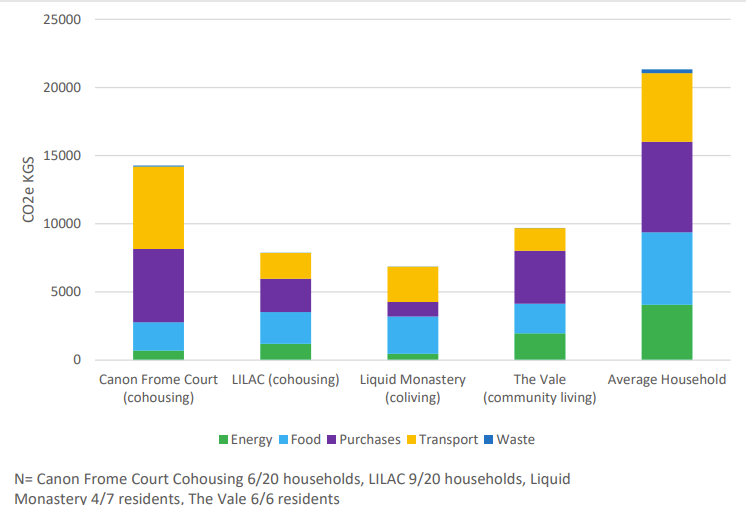Homes in which
spaces, resources and social time are shared,
have the potential to lower domestic environmental impacts
and change our habits for the better.
However, to what extent is this true?
In this article, Dr Penny Clark summarises her findings from her award-winning PhD, which explored environmental sustainability in forms of shared living, including coliving.
Winner of the Coliving Award, Academia Category 2022
Having been judged by experts and put to the public vote, Penny Clark won the Coliving Award, Academia Category 2022, for her PhD Thesis.

Summary of the research
The title of the thesis is: “Practices of shared living: Exploring environmental sustainability in UK cohousing, community living, and coliving.”
It explores two questions:
- Is shared living more environmentally sustainable than the average household?
- If so, how and why?
Key findings
- The shared living case studies had GHG emissions at between 32 and 67 percent of the average household;
- In studying practices, infrastructures and social networks within shared living, this research identifies four types of sharing that are significant to pro-environmental outcomes: shared ideals, shared governance, shared materials and spaces, and shared endeavour. For each type of sharing, the findings describe and analyse how processes of negotiation enable and constrain pro-environmental practices and outcomes;
- By exploring these processes, this research generates new knowledge on how and why shared living can produce lower-than-average domestic environmental impacts. Thus, the research demonstrates the potential and the mechanisms by which shared living may offer environmentally sustainable housing solutions.

3 key innovations from the research
- Quantitative evidence that coliving has lower greenhouse gas emissions than the average household;
- Detailed insight into why coliving and shared living enables lowered environmental impacts;
- A clear, comprehensive framework through which to understand how shared living can lower environmental impacts.
Why undertake this research?
Currently, homes in the developed world are too polluting, and lowering domestic greenhouse gas emissions (GHGs) is vital if we are to maintain a habitable planet. Innovative housing solutions are needed. More than this, Western culture still chiefly values wealth, privacy and sole ownership as key parts of what makes for a successful and prosperous life. Given the crises of housing, loneliness, and sustainability, we must shift our understanding of prosperity.
Shared living (in which residents share spaces, resources and social time) may present part of the answer. This study breaks new ground through exploring environmental sustainability in UK coliving, cohousing and community living. It is the first academic study to measure the GHGs of a coliving community.
Qualitative insights on shared living communities and sustainability
Interviews, focus groups, and observation produced a wealth of qualitative data. From this, how shared living communities negotiated sustainability-related practices could be explored. The following are some of the highlights which emerged from the qualitative research:
- On sharing values and creating pro-environmental social norms. What sustainable practices consist of, and how people negotiate when to undergo such practices, differs widely. However, social norms within communities provided a context which shaped individual actions. This context was sometimes different to that of other (non-residential) communities that individuals were a part of (e.g. work, other friends). If the community had a shared and co-created articulation of sustainability-related values, then individuals were more likely to “make an effort” to be sustainable.
- On social coordination and sustainability. Tools to aid in social negotiation and shared governance (such as nonviolent communication and shared decision-making processes) can enable sustainable practices. This is because they facilitate the sharing of spaces, resources, and social time, all which can have pro-environmental outcomes.
- On sharing spaces and resources. Learning how to share spaces and resources with a sense of social ease is a skill, and can require active and mindful negotiation around expectations. Being able to achieve a sense of comfort/privacy in shared spaces is important for community longevity and use of communal areas. It is reductive to think of spaces as either private or shared: it is more helpful to think of temporalities and actions as private or shared. This framing will enable greater flexibility in how to understand resident needs in terms of privacy and sociability.
- On how friendships can facilitate sustainable habits. With strong social relationships there is more likelihood that residents will share spaces and resources (which can lower environmental impacts). It is also more likely that residents will pick up habits from one another. The research found that pro-environmental habits, such as flying less, reducing meat consumption, and cycling, were shared amongst residents with strong social connections.
- On making sustainability easy. The community in this research who had the lowest environmental impact were, as a whole, not the most passionate about sustainability. Rather, their infrastructures made sustainable options the easy and most financially viable choice. For example, sharing a kitchen and bathrooms lowered the rent. Riding a bicycle and taking public transport was cheaper than running a car. Picking (unpackaged) food up from the local market was easy and quick. From this we can conclude that if you want residents to engage in sustainable practices – make it the obvious and easy thing to do!
- On harnessing the power of collective action. Collective action could be slow, frustrating, and difficult. It could also be powerful: an antidote to antipathy and feelings of helplessness, and a means by which people could achieve far more than they could do alone. Facilitating collective action which has positive environmental and/or social impacts can create powerful and valuable experiences for residents.
- On ‘larger-than-self’ thinking. Some residents made connections between caring for the community, with caring for the environment and the wider world. Both were a mode of caring for something larger than themselves.
Applications
Application for planners and policymakers
- This research frames shared living and coliving as a potential sustainable housing solution, and so may provide greater impetus for recognising and enabling shared living.
- It may encourage planners to be more receptive to approving planning applications.
- It may encourage stronger policies to enable shared living e.g. funding and advisory support, regulations.
- This research also illustrates the potential for social infrastructures (e.g. tools and frameworks for negotiation and conflict management) in facilitating a high quality of life in shared living arrangements.
- It therefore argues that such social infrastructures become as important as physical infrastructures within shared living policy and practice.
Application for architects, designers and engineers
- As the demand for sustainability rapidly rises, this research will encourage shared living specialisation of architects, interior designers and other built environment professionals.
- This research maintains that social infrastructures should not be neglected, as they have great potential to spread and enable pro-environmental practice. This requires greater levels of resident engagement and cooperation. Therefore, this research encourages new competences around co-design for built environment professionals.
- The insights into how residents use shared spaces may also prove useful for architects and interior designers when designing coliving/shared living projects.
Application for shared living operators/developers
- This research may aid coliving developers with their planning applications, through demonstrating the sustainability benefits of coliving / shared living.
- This research also offers coliving operators a method for measuring their operational environmental impacts.
- The research encourages coliving operators to think about how the sharing which occurs in coliving can have sustainable outcomes. It sheds insight into how a sustainable culture can be created.
- It shows how social infrastructure is part of sustainability. It demonstrates how community and sustainability are deeply intertwined.
Research Impact
- Research results featured in the Leeds Local Plan, 2021
- Research results featured in the UK’s first cohousing impact report
- Cited in planning applications for two coliving developments, in the UK and Australia
- Article published in Coliving Insights No. 3: ‘Creating Cultures of Pro-environmental Practice’
- Guest lecture at design school Hyper Island, 2020
- Presentation at Communal Studies Association, 2019 & 2021
- Keynote presentation given at the Intentional Communities Symposium, 2021
- Informed Conscious Coliving blog post on sustainability and coliving
- Research informed presentation at the UK Cohousing Network, June 2022
- Winner of the Coliving Award, Academia Category 2022
- Research informed the Coliving in 2022 & Beyond Guide
Read the thesis
This article has been authored for you by:
Penny is Director of Research & Sustainability at Conscious Coliving. She has an MSc in Social Research Methods, and her PhD explores how shared living may enable lowered environmental impacts. She has consulted on numerous shared living projects, specialising in impact strategy, concept, and community. Penny has presented at conferences including the Co-Liv Summit, the Urban Living Festival, BTR360 and more. She has also authored publications in The Developer, Coliving Insights Magazine, the book Urban Communal Living in Britain, as well as being interviewed by the BBC and the Guardian about shared living.
